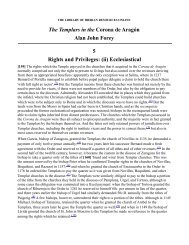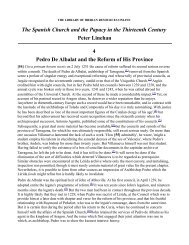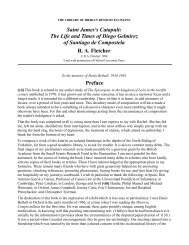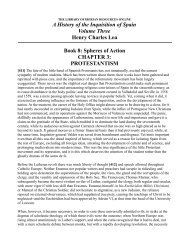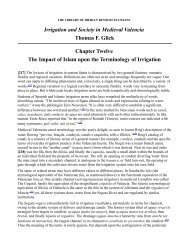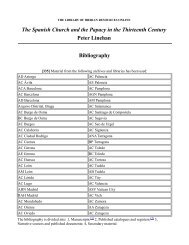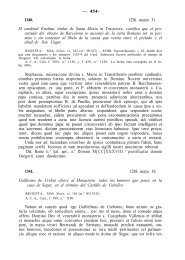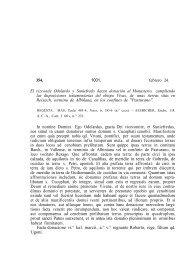Chapter 6 - The Library of Iberian Resources Online
Chapter 6 - The Library of Iberian Resources Online
Chapter 6 - The Library of Iberian Resources Online
You also want an ePaper? Increase the reach of your titles
YUMPU automatically turns print PDFs into web optimized ePapers that Google loves.
nobles as patrons. When the Duke <strong>of</strong> Medina Sidonia died in 1558, his body was taken there. When<br />
Philip II visited Seville in 1570, he stayed there. (39)<br />
Despite its wealth and fame, the monastery was also known as a refuge for criminals and heretics. In<br />
the fifteenth century its patron, the Count <strong>of</strong> Niebla, wrote <strong>of</strong> cleaning out the monastery: [133] "well,<br />
the cave <strong>of</strong> thieves has been turned into a house <strong>of</strong> prayer, in which our Lord is now served." (40) In the<br />
sixteenth century the monastery became the refuge for a group <strong>of</strong> Protestants. Its prior and several<br />
members, as well as several nuns <strong>of</strong> the nearby Jeronomite convent <strong>of</strong> Santa Paula, were secure in this<br />
monastery until the late 1550's, when they had to flee the Inquisition. <strong>The</strong> Inquisition found that the<br />
monastery was one <strong>of</strong> the major centers <strong>of</strong> Spanish Protestantism, and that it had been used as one <strong>of</strong><br />
the depositories for New Testaments printed in the Castilian language and smuggled into the country by<br />
Protestants. (41) In 1567 Philip II ordered the reduction <strong>of</strong> this monastery and six others. "<strong>The</strong> causes<br />
that moved the king to this decision (which time has borne out)," wrote one chronicler, "were the small<br />
amount <strong>of</strong> conformity in the superiors <strong>of</strong> these houses that disrupted in them the religious observance."<br />
(42) One year later the hermit monks <strong>of</strong> San Jerónimo, who had occupied the monastery, were<br />
incorporated into the larger Order <strong>of</strong> the Monks <strong>of</strong> San Jerónimo by order <strong>of</strong> the Crown, undoubtedly a<br />
move to bring the monastery under stricter control.<br />
<strong>The</strong> Crown wanted to curb the monastery <strong>of</strong> San Isidro del Campo because its wealth and fame and<br />
physical separation from Seville were increasing its independence. Philip II seemed less interested in<br />
the scriptural hair-splitting <strong>of</strong> heresy than in the political threat <strong>of</strong> a religious group who questioned the<br />
religious conformity buttressing his throne. He welcomed monasteries in his kingdom, but only if they<br />
supported this conformity. In Hapsburg Spain the Church could continue as a refuge only for people<br />
who did not threaten the teachings <strong>of</strong> the Church or the power <strong>of</strong> the secular order.<br />
THE CHURCH AS CARICATURE<br />
Underworld people used the Church as a butt for jokes and tricks. Tipsy prisoners dressed up as priests<br />
and held raucous [134] religious "services." Ruffians broke into city brothels and hooted as priests<br />
preached and tried to convert prostitutes there. False beggars posed as monks collecting money to buy<br />
oil for church lamps. Street children hid their stolen loot behind altar pieces. Criminals masqueraded as<br />
priests and escaped prison in pious dignity. (43) What is the significance <strong>of</strong> these jokes and tricks at the<br />
expense <strong>of</strong> the Church?<br />
Much underworld humor can be regarded as a strategy for survival. <strong>The</strong> false beggar posing as an almsgathering<br />
monk took hard-earned maravedís from a pious widow in order to have money for food,<br />
drink, and gambling. He also played this trick in order to laugh at the absurdity and misery <strong>of</strong> the world<br />
around him. If he could not occasionally laugh at some poor wretch, he would probably disintegrate<br />
under the burdens <strong>of</strong> his own miseries. His joke got bread for him, and it also preserved his mental<br />
health.<br />
Underworld jokes were <strong>of</strong>ten expressions <strong>of</strong> bravado. Prisoners who presented a religious "service" in<br />
the prison were making fun <strong>of</strong> the priest's performance before an altar, but they were also crying out<br />
against impotence. Tomorrow the priest might be able to lead them as lambs to the gallows, but tonight<br />
they could show how ridiculous he was as he bowed and chanted and mouthed words that he might not<br />
understand. Ridiculing the Church helped these prisoners to feel less impotent in the clutches <strong>of</strong><br />
authority.<br />
Bravado can bluster away fears. Prisoners who dressed up in white penitential robes to accompany two<br />
condemned highwaymen to the gallows turned this religious ritual into a blasphemous carnival. <strong>The</strong>y<br />
put on false moustaches, squabbled over rosaries, and proudly preened themselves to the dismay <strong>of</strong> the





